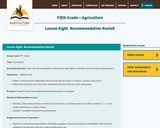
Students learn that making stewardship decisions is complex.
- Subject:
- Agriculture
- Career and Technical Education
- Material Type:
- Activity/Lab
- Lesson
- Author:
- Wyoming Stewardship
- Date Added:
- 08/21/2019


Students learn that making stewardship decisions is complex.
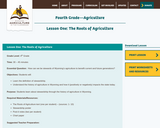
Students learn about stewardship through the history of agriculture in Wyoming.

Five-day unit plan to teach classroom rules, recognizing values, emotions, strengths and struggles, and teamwork. Great way to teach and practice expectations for speaking and listening, as well as creating a class identity.
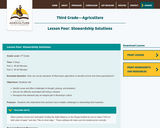
Students will understand that ranchers face multiple challenges in stewarding their livestock.
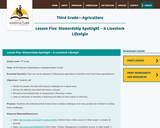
Students will understand that livestock face multiple challenges and many people are involved in solving those challenges.
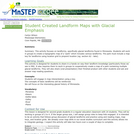
Students learn glacial landforms and create a landform map including a location grid (eg. position A2) and map key.

PRODUTO DE MESTRADO 2021 (PROFCIAMB-UFPA). UM GUIA DIGITAL PARA CONSTRUÇÃO DE FILTROS ARTESANAIS
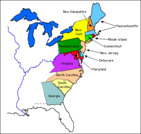
Students will use both primary and secondary sources (links in lesson) to research one or a group of the 13 original colonies and create a report or presentation. They will also identify the colonies on a map quiz. Being able to identify geographical locations and use map skills is always beneficial, for both school and beyond. This lesson will also provide students with the ability to compare and contrast different colonies and explain their importance to the development of a nation based on geographical connetions to industry/agriculture and their origination and it's impact on history. (For example, the colonies that began with a king's charter were more likely to have citizens who remained loyal to Britian during the War for Independence.)
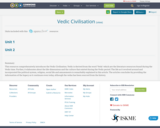
This resource comprehensively introduces the Vedic Civilisation. Vedic is derived from the word ‘Veda’ which are the literature resources found during the Vedic time. Further, it elaborates about the life-dimensions and the culture that existed during the Vedic period.
The life as it revolved around and incorporated the political system, religion, social life and amusements is remarkably explained in this article.
The articles concludes by providing the information of the legacy as it continues even today, although the vedas has been sourced from the history.
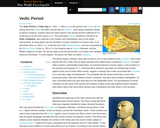
This resource comprehensively introduces the Vedic Civilisation. Vedic is derived from the word ‘Veda’ which are the literature resources found during the Vedic time. further, it elaborates about the life-dimensions and the culture that existed during the Vedic period.
The life as it revolved around and incorporated the political system, religion, social life and amusements is remarkably explained in this article.
The articles concludes by providing the information of the legacy as it continues even today, although the vedas has been sourced from the history.
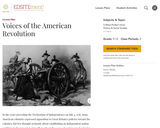
This lesson helps students "hear" some of the diverse colonial voices that, in the course of time and under the pressure of novel ideas and events, contributed to the American Revolution. Students analyze a variety of primary documents illustrating the diversity of religious, political, social, and economic motives behind competing perspectives on questions of independence and rebellion.

This is a unit over the War of 1812 complete with Pre/Post Assessments, notes, resources and activities. It is an online unit designed for students to work independently at their own pace, but with modifications, teachers can adjust it to meet their needs. It is also designed to allow students choice in how they will take their notes, and how they will study.
Teachers will need to “Make a Copy” of various materials within the unit. Particularly the quizzes so they can have access to student results. They will also need to link those quizzes within the Student Outline so students will have access to them. Teachers are also encouraged to adapt the materials as needed to fit their classrooms and students as long as they follow the copyright guidelines.
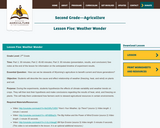
During the experiments, students hypothesize the effects of climate variability and weather trends on crops. They will then test their hypothesis and make conclusions regarding the results of heat, wind, and freezing on plants. This will help them understand how farmers work to steward agricultural resources in certain environments.
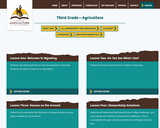
Students will understand that we must be stewards of Wyoming. Throughout the course of the unit, students will develop this idea of stewardship.

Students will learn to speak to a group and listen while others speak.
Students will learn about similarities and differences within the classroom and with our families. (Extension will be to make symbolic flag for families which leads into the US Symbols lesson).
Students will learn the meaning of strengths and struggles and begin to understand what their own strengths and struggles are.
Students will learn how they can help others in the class throughout the year, as well as others in their families.
Students will produce a class quilt of pictures of working collaborative to help each other.
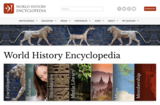
World History Encyclopedia is a non-profit organization publishing the world's most-read history encyclopedia. Its mission is to engage people with cultural heritage and to improve history education worldwide.
The website offers thousands of free history articles, with a writing style aimed at students from middle school level and up. Articles are complemented by videos, timelines, 3D models, and interactive maps. The search function offers many filters, including the possibiliy to search for primary source texts.
Additionally, the organization published free teaching materials in its education section (https://www.worldhistory.org/edu/).
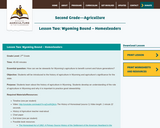
Students learn about the history of agriculture in Wyoming. Students develop an understanding of the role of agriculture in Wyoming and why it is important to practice good stewardship.
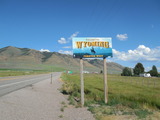
Students will memorize the major mountain ranges, rivers and places in the state and identify them on maps. This is important learning prior to learning Wyoming history and the change over time of people across the state. Understanding local geography has life-long benefits, but it is especially useful in understanding the changes over time to our state and will help students build mental pictures of events in Wyoming history.

This activity is in the form of a story map and a video about important archaeological sites in Wyoming, which includes several interactive web maps that allow students to zoom in and out to compare locations of archaeological sites in Wyoming and click on for photos and more information. Students will be able to compare the different archaeological time periods and types of sites such as rock art, sacred sites and hunting sites. Students can explore sacred and historical sites important to the Lakota tribes greater detail at this story map about northeastern Wyoming and the Black Hills. This resource includes interactive maps and videos narrated by Lakota historian, Donovan Sprague. Students will explore locations of importance to the Lakota and hear legends associated with these places as well as historical events described from the perspective of indigenous people.
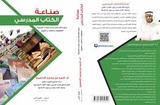
قراءة تحليليه